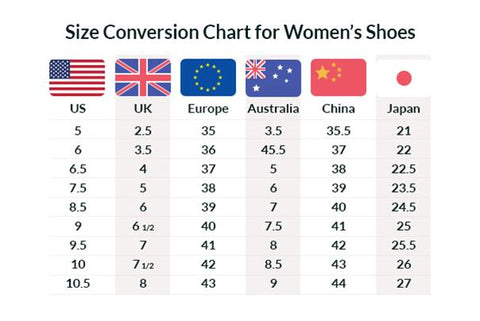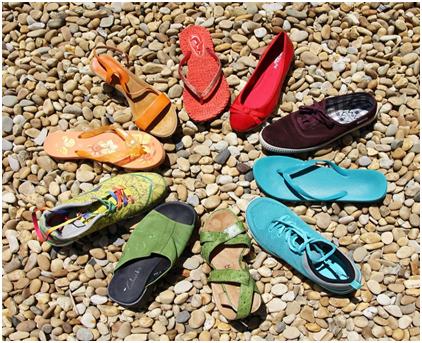The Ultimate Shoe Buying Guide

Buying shoes is not just a fashion choice – it’s also an important health decision. Our feet carry up to three times our body weight so it’s crucial that we choose shoes that will protect our feet. In their lifetime, the average person walks the circumference of the earth four times – you need your shoes to be comfortable!
Things To Remember Before Buying Shoes
Before you start looking for your perfect pair of shoes, it’s important to remember the following:
Anatomy of the Shoe
This video explains the different parts of the shoe.Consider The Shape Of Your Feet!
Feet come in all different shapes & sizes. To get the perfect fit and to avoid painful problems, make you consider the size and shape of your feet. Remember that your shoes should conform to the exact shape of your feet. Never force your feet to be conformed to the shape of the shoes.
Width and Length
If your shoes are too wide or narrow, it can lead to painful calluses and blisters. Additionally, a toe box that's not high enough (i.e. it does not give you enough room for your toes) can increase the chance of foot disorders like hammertoes & bunions.
As you walk, your arches play a significant role in how you adapt to different surfaces. The complex alignment of tendons, muscles, bones and ligaments in your feet form both longitudinal (lengthwise) and metatarsal (side-to-side) arches. While walking, these flexible, bouncy arches support and dispense your body weight consistently across your feet. When buying shoes, you should pick shoes based on your arch type. For the most part, your feet will fit into one of the following categories:
Low-Arched or Flat Feet
For some people, low arches (or flat feet) can contribute to joint problems and muscle stress. If you have considerably flat feet, ensure that you look for a shoe with a straight last* & motion control – this will help to stabilise your feet.
*Last refers to the shape of the sole and the footprint around which the shoe is built.
Neutral-Arched Feet
If you’re feet aren't overly arched or overly flat, you have neutral-arched feet. Keep an eye out for shoes with straight to semi curved lasts, moderate rear-foot stability and firm midsoles.
High-Arched Feet
People with high arches can often have extreme strain on their muscles and joints. This is because your feet may not absorb shock very well, particularly if you participate in lots of jumping or impact activities. When choosing shoes, make sure they have a curved last and cushioning to recompense for your lack of natural shock absorption.
Not sure about your foot type?
Your old shoes can give you clues as to the shape of your foot. Bring your old shoes with you when you’re shopping for a new pair. Most shoe professionals will be able to give you some tips on what shoes you should be based on the wear of your old shoes. Another way of checking is by dipping your foot in water then stepping on to a piece of cardboard. Analyse your footprint. If you’re able to see very little of your footprint, it’s highly likely that you have high arches. If you can see most of your footprint, you more than likely have low arches.
How To Get The Best Fit: Our Top Tips
- No matter how stylish, fashionable or expensive your shoes are, if they don’t fit properly, they aren’t doing their job. When you’re trying to find the best fit in a pair of shoes, keep the following pointers in mind:
- If applicable, wear the same type of socks you usually wear to the shop so you can get the right fit.
- When shopping for shoes, make sure you go later in the day or after you have been walking around for a while – your feet swell as the day progresses so this is when your feet are at their largest.
- Make sure you buy your shoes at a shop that has lots of different options for you to choose from or at a shoe shop with professional fitters.
- Measure your feet before you start your search or ask the shoe salesperson to measure both feet for you. Stand upright while your foot is being measured so you get the most precise measurement.
- It’s important that you measure your feet every time you buy shoes as your foot size can progressively change over years.
- If one of your feet is bigger than the other, try on a pair that fits the bigger foot.
- When you have a new pair on, wiggle your toes.
- If you do not have at least the width of your finger between your longest toe and the end of the shoe, try a bigger size.
- Ensure that the shoe is wide enough. The side-to-side fit of the shoe should be comfortable and snug – not tight.
- Walk around in the shoes before you buy them – they should feel comfortable straight away. Ensure that your heel fits comfortably in each shoe so that it doesn't slip as you walk.
Tips for Wide Feet
- Pointy toed shoes are best avoided if you have wide feet as they tend to squeeze in the toes.
- Round-toed shoes tend to be the most comfortable option if you have wide feet.
- Lots of online shoe shops cater specifically for wider feet so ensure you spend time browsing through all of the different options available.
- Avoid shoes with a lot of straps as these can constrict wide feet.
Tips For Narrow Feet
- If you prefer to try on your shoes before purchasing, start off doing your search online and then find out where the nearest provider is located.
- If the back of your foot is slipping around in your shoe, heel inserts can be very helpful.
- Never stuff your shoes with toe pads or cotton balls – these can slip and slide in your shoes which can cause more problems.
Tips for Small / Large Feet
- Do your research – not all shoe shops will stock shoes in smaller/larger sizes or there might be a limit on the amount that they supply. Finding out what shops are friendly towards small and/or large feet will make for a more enjoyable shopping experience.
- Avoid the temptation to get shoes in a size too big or too small. If the shoe shop doesn’t have your size in stock, consider looking online for alternatives or wait until your size has been restocked.
- If you have large feet and you’re looking for athletic footwear, it might be worthwhile browsing the men’s selection of footwear. In general, larger sizes are available so you’ll have lots of options to choose from.
- If a shop does not stock your size in the desired style be sure to ask if it can be ordered for you from the supplier.
International Shoe Size Conversion Guide
Shoe sizes aren’t standardised. Ensure you’re familiar with the brand’s sizing before purchasing online and if you’re in store, make sure you try a half size smaller or larger just in case. You can view our shoe size guide here. This chart is a general guideline on how shoe sizes compare across the globe:
Make Sure You Make An Informed Decision!
Poorly fitting shoes are the source of so many health problems from corns to ingrown nails. You can shop with confidence now that you know what features to look for. Make sure you always wear shoes that are properly fitted and comfy so you can walk worry free!






